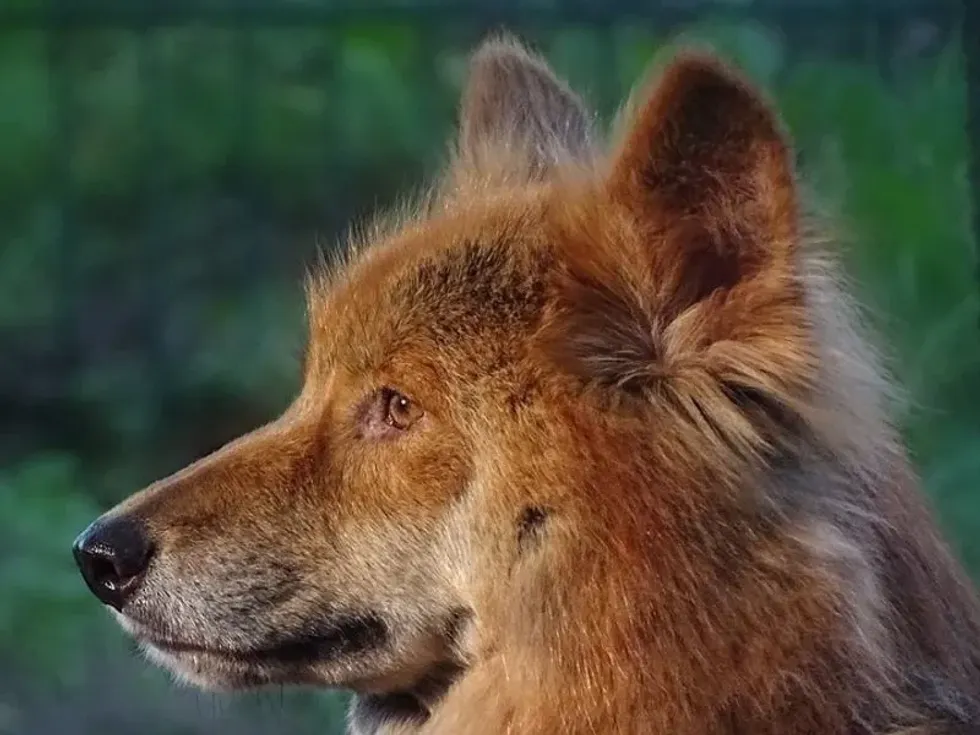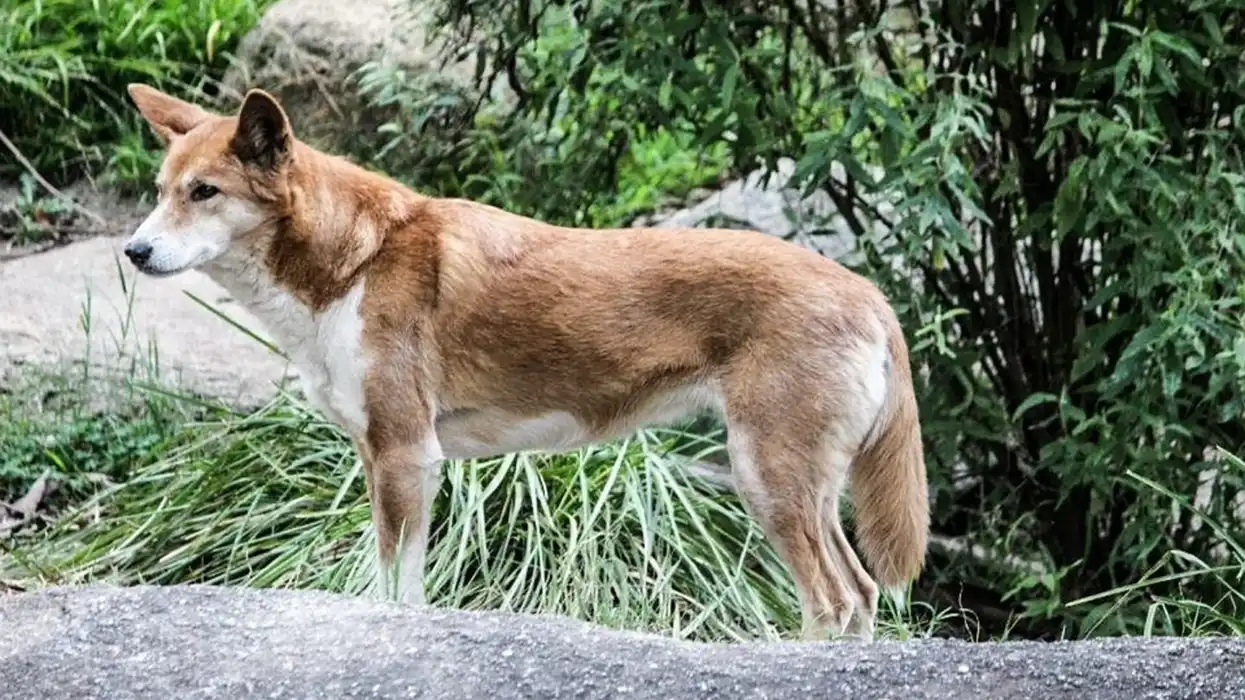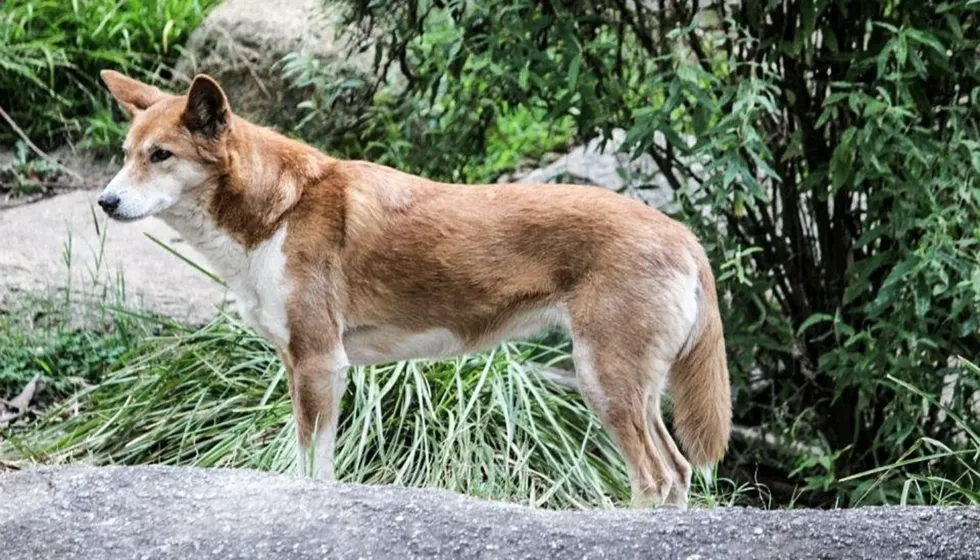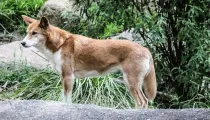Fun Australian Dingo Facts For Kids

The dingo (Canis familiaris dingo, Canis familiaris, Canis dingo, or Canis lupus dingo) is a legendary dog from Australia's prehistoric lineage.
The dingo is famous for being Australia's wild dog, but they can also be found in Southeast Asia. These Australian animals might have descended from Asian dingoes that arrived on the continent between 3,000 and 4,000 years ago.
The dingo is a medium-sized canine with a lean, hard body that has been modified for speed, agility, and endurance.
Light tan or ginger, tan and black, or creamy white are the three principal color variations of the dingo. The skull is wedge-shaped and looks to be very massive in comparison to the rest of the body.
Dingoes are also closely related to the New Guinea singing dog and the New Guinea Highland wild dog, whose lineage separated early from todays domestic dogs and can be traced back to Asia via the Malay Archipelago.
Dingo morphology has not altered over the past 3,500 years, implying that no artificial selection has been used during this period. The oldest known dingo fossil was discovered in Western Australia around 3,450 years ago.
However, according to genomic analysis, the dingo arrived in Australia around 8,300 years ago, but the human population that carried them there is unknown.
Dingoes habitats span the majority of Australia, but they are absent from Tasmania, and a small portion of the southwest. Dingoes are Australias biggest living terrestrial predators, and they prey on mammals such as the large red kangaroo, as well as birds, reptiles, fish, crabs, frogs, insects, and seeds.
The native quoll and the wild cat are all rivals for the dingo.
A dingo pack normally consists of a mated pair, their current-year offspring, and sometimes previous-year offspring. When compared to the Extinct thylacine, also known as the Tasmanian wolf or Tasmanian tiger, the dingo plays a significant role in indigenous Australian stories, however, they are rarely portrayed in cave paintings.
If you enjoyed our factual and simplistic breakdown of the Australian dingo dog, go through our other articles on the pocket pitbull and the lab chow mix.
Australian Dingo Interesting Facts
What type of animal is an Australian dingo?
Australia's wild wolf, the dingo, is a legendary dog. This breed is now one of the native species of Australia.
What class of animal does an Australian dingo belong to?
Australian dingoes belong to the class mammalia.
How many Australian dingos are there in the world?
Dingoes, feral dogs, and crossbreeds of the two occur in the Australian bush, resulting in dingo–dog hybrids. They are scarce in Australias eastern half as well as parts of the northern territory and south Australia, but they are widespread in the rest of the continent.
Dingoes aren't on the verge of Extinction and rough estimates put the number of dingoes in Australia at 10,000 to 50,000.
Where does an Australian dingo live?
Forests, mountains, rural areas, and plains are all home to the Canis lupus dingo. They can also be observed in desert environments. Birthing dens are created in places like rabbit holes, caves, and hollow logs that are close to water. Dingoes do not prefer a domesticated environment.
What is an Australian dingo's habitat?
The Canis lupus dingo habitat in Australia can range from woodland, plains, and mountainous rural areas. They also live in Central Australias desert areas, where cattle waterholes are available.
They prefer to be close to a water source, and therefore, you are bound to find their natal dens around any water body. The majority of the Asian dingo population lives around villages, where humans exchange shelter and food to protect their houses.
Who do Australian dingos live with?
The social behavior of the dingo is similar to a coyote or grey wolf, which is one of the reasons why they were once thought to be a descendant of the Indian wolf. While young males are nomadic and solitary, adults form a settled pack.
Breeding pairs, on the other hand, remain together in areas of the habitat where the population is dispersed. A dingo pack normally consists of a mated pair, their current-year offspring, and sometimes previous-year offspring.
When conditions are favorable for dingo packs, the pack is stable with their own territory, and they only have small overlaps with their neighbors. The various sizes of prey available in the pack's territory sometimes appears to correspond to the size of the pack.
Smaller groups of dingoes live in desert areas, with less rigid territorial behavior and water sharing. The average monthly pack size is between three and twelve.
How long does an Australian dingo live?
Dingoes can live up to ten years in the wild and 20 years in captivity. This is because they have no naturally occurring infections and are immune the paralysis tick which can otherwise be fatal.
How do they reproduce?
Dingo groups are dominated by a single pair. Females who are dominant will often consume other females' offspring. Dominant pairs usually stay together for the rest of their lives. Other pack members assist in the care of the dominant pairs young.
Dingoes only have one litter of pups in a year. Dingo mating seasons vary according to latitude and seasonal conditions.
Dingos mate in March and April in Australia, and August and September in Southeast Asia. Their gestation period, on average, is 63 days, and litter sizes range from one to ten, with an average of five per litter.
Females and males pair up in their third to fourth year stay together for the rest of their lives. Except in Australian national parks and other protected areas, dingoes and domestic dogs freely interbreed, and populations are largely hybridized.
What is their conservation status?
Dingoes are spread throughout Australia. Dingoes are protected in national parks under the Nature Conservation Act of 1992 because of the Australian Government which classifies them as native animals.
Dingoes are wild mammals that should be interfered with as little as possible. Dingoes and domestic dogs will breed.
Unfortunately, interbreeding threatens the dingoes ability to exist as a distinct subspecies thus threatening the dingo populations. Interbreeding has become a significant issue along the more populated mainland coastal areas and in some inland areas, weakening the unique nature of this native animal. Due to interbreeding with domestic dogs, there is a danger of complete hybridization.
It is critical to keep the population of wild dogs under control in order for the dingoes to exist as separate subspecies. Due to their isolated location, dingoes on Fraser Island seldom interbreed with domestic or wild dogs.
Australian Dingo Fun Facts
What do dingoes look like?
Their body fur is short, but their tail is thick. The dingo is Australia's largest mammal and they have a dog-like appearance with a comparatively wide head and erect ears.
The dingoes muzzle is long and tapered, with canine teeth that are longer than those of a domestic dog. Depending on where they live, the dingo can grow to be over 22-23 in (56-59 cm) tall and weigh between 22–33 lb (10–15 kg).
Dingoes are naturally lean, with pricked tails that have a white tip. Dingoes are often sandy-yellow in color, but they can also be black or tan.

How cute are they?
The species, although not habitable with humans, are very cute. The colors of the dingo in Australia range from sandy-yellow to black or tan. Dingoes in Australia can be very adorable and photogenic. Australian dingo pictures are quite popular amongst wildlife enthusiasts.
How do they communicate?
Dingoes may live alone or in a group of up to ten members. They travel long distances and communicate by howling like wolves.
Howls, growls, chortles, yelps, whines, chatters, snorts, and purrs are among the vocalizations used by dingoes. Dingoes will bark, but only on rare occasions.
A dingo bark is usually a single sharp bark rather than a series of yaps. When predators are present, a sharp, low-pitched "woof" is often used as a warning sound.
If a mother suspects danger is coming, she will use this sound to call her cubs back to the den. Body language is often used as a primary means of communication, with movements of the ears, eyes, mouth, tail, and head being used to communicate with one another.
How big is an Australian dingo?
Australian dingoes are a medium-sized carnivorous mammal. These animals have a head-to-tail length of 42-48 in (3.5–4 ft). The tail lengthens them by 12-13 in (30-33 cm). A regular wolf is about three times the size of a dingo.
How fast can an Australian dingo run?
Dingoes can run at 37 mph (60 kmph) and climb trees successfully.
How much does an Australian dingo weigh?
Australian dingoes are carnivorous mammals that weigh between 22–33 lb (10–15 kg). Males tend to be bigger and heavier than females.
What are the male and female names of the species?
Although dingoes have no specific female or male names, the alpha male and female are the leaders of the pack and normally the only pair to breed.
What would you call a baby Australian dingo?
Cubs, or Australian dingo puppies, refers to the offspring of the dingo alpha female and alpha male.
What do they eat?
A dingoes diet consists of a variety of foods because they are opportunistic carnivores. They normally hunt for food alone, sometimes in pairs, and in the case of large prey they may form hunting packs.
When available, the diet may consist of kangaroos, wallabies, possums, wombats, reptiles, birds, insects, eggs, and aquatic life. Consuming carrion as a food source has a substantial positive impact on the natural environment.
The dingo's diet has increased to include wild animals such as rabbits, hare, goats, cats, foxes, and pigs since the introduction of foreign species to Australia. Dingoes diet preferences, including these wild species, are helping vulnerable native flora and fauna to regenerate in some parts of Australia.
Dingoes diets play an important ecological role in the conservation of Australian biodiversity.
Are they slobbery?
Yes, anecdotal sources confirm that these animals are slobbery.
Would they make a good pet?
Although dingoes live in the wild, they have not been selectively bred in the same way as any domestic dog. If you keep a dingo from under six weeks old and train them, you could keep them as a pet.
Unfortunately for city dwellers interested in adopting a dingo, these dogs cannot be kept in an apartment as they need a lot of space to roam. As a result, their status as a domestic animal is ambiguous.
Did you know...
Dingoes are much more flexible than dogs. They would subluxate their hips and spin their wrists.
These adaptations help with hunting and burrowing. The skull is the broadest component of a dingoes anatomy which can keep them safe through tighter squeezes, and the dingoes body will follow its head through any hurdle.
Dingoes are thought to be extinct in New South Wales, and that virtually all dog-like animals in the wild are merely wild dogs.
This belief is reinforced by laws and practices in New South Wales, which have replaced the term 'dingo' with 'wild dogs'. The dingo fence is a landmark in Australia and one of the worlds longest buildings.
It extends over 5,600 kilometers across three states, including 150 kilometers through the Strzelecki Deserts red sand dunes. The dingo fence has only had one purpose since it was built in the early twentieth century which is to keep the wild dingoes out.
Why is an Australian dingo not a dog?
Because they came from domesticated ancestors, the dingo is considered a wild dog. Dingoes have a commensal relationship with indigenous Australians, in which two species live in close proximity but are not dependent on each other for survival.
Dingoes are not Canis familiaris, but an entirely different species and this is very important to understand.
According to scientists, dingoes have anatomical characteristics that distinguish them from dog breeds and wolves, such as they have a broader head and longer snout. Dingoes are not necessarily tan, they can also be black, white, or medium brown, according to research.
What are some fun facts about Australian dingoes?
Female dingoes have only one breeding season per year, from March to June. Dingoes have no odor because they are natural predators. Dingoes are immune to paralysis ticks and have no natural health problems.
Here at Kidadl, we have carefully created lots of interesting family-friendly animal facts for everyone to discover! Learn more about some other mammals including mexican wolf, or cheagle.
You can even occupy yourself at home by drawing one of our dingo coloring pages.
We Want Your Photos!
More for You
See All
Bachelor of Commerce specializing in Accounting and Finance, Master of Business Administration

Divya RaghavBachelor of Commerce specializing in Accounting and Finance, Master of Business Administration
With a diverse range of experience in finance, administration, and operations, Divya is a diligent worker known for her attention to detail. Born and raised in Bangalore, she completed her Bachelor's in Commerce from Christ University and is now pursuing an MBA at Narsee Monjee Institute of Management Studies, Bangalore. Along with her professional pursuits, Divya has a passion for baking, dancing, and writing content. She is also an avid animal lover who dedicates her time to volunteering for animal welfare causes.
Bachelor of Business Management specializing in Financial Management

Sapna SinhaBachelor of Business Management specializing in Financial Management
Sapna has a Bachelor's degree in Business Administration from Poornima University, Rajasthan. She has writing experience from working for a news agency as a writer, interning at various companies, and writing and editing articles on education.
Disclaimer
1) Kidadl is independent and to make our service free to you the reader we are supported by advertising. We hope you love our recommendations for products and services! What we suggest is selected independently by the Kidadl team. If you purchase using the Buy Now button we may earn a small commission. This does not influence our choices. Prices are correct and items are available at the time the article was published but we cannot guarantee that on the time of reading. Please note that Kidadl is a participant in the Amazon Services LLC Associates Program, an affiliate advertising program designed to provide a means for sites to earn advertising fees by advertising and linking to Amazon. We also link to other websites, but are not responsible for their content.
2) At Kidadl, we strive to recommend the very best activities and events. We will always aim to give you accurate information at the date of publication - however, information does change, so it’s important you do your own research, double-check and make the decision that is right for your family. We recognise that not all activities and ideas are appropriate for all children and families or in all circumstances. Our recommended activities are based on age but these are a guide. We recommend that these ideas are used as inspiration, that ideas are undertaken with appropriate adult supervision, and that each adult uses their own discretion and knowledge of their children to consider the safety and suitability. Kidadl cannot accept liability for the execution of these ideas, and parental supervision is advised at all times, as safety is paramount. Anyone using the information provided by Kidadl does so at their own risk and we can not accept liability if things go wrong.
3) Because we are an educational resource, we have quotes and facts about a range of historical and modern figures. We do not endorse the actions of or rhetoric of all the people included in these collections, but we think they are important for growing minds to learn about under the guidance of parents or guardians.







